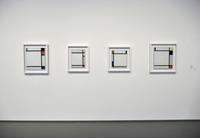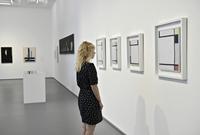Research
The wealth of the epochs and genres as well as the museum’s own eventful history offer multifaceted scholarly and educational possibilities. These include conservational work as well as art historical projects dedicated specifically to groups of works in the collection as well as research into the provenance of the museum’s holdings.
initial check on colonial contexts oft he ethnographic holdings of the kunstmuseen krefeld
As part of an initial check by the German Center for the Loss of Cultural Property, the inventory of so-called ethnographic objects of non-European origin at the Kunstmuseen Krefeld could be researched. From October 2022 to March 2023, the ethnologist and historian Gesa Grimme examined the collection of around 115 objects from Africa, South and East Asia, and Oceania. She was able to clarify preliminary provenances as far as consignors and dealers. As far as possible, the cultural objects, which had previously been almost completely unexplored, were given an initial geographical and cultural classification of their origin. At the same time, a localization in German as well as European colonial history was undertaken. The suspicion of appropriation in colonial power relations was confirmed for most of the objects. Due to the insufficient archival situation, it was not possible to uncover stringent chains of provenance up to the societies of origin. Sensitive collection items were named. Finally, the objects were located in the history of the institute with regard to their colonial context.
The collections of the Kunstmuseen Krefeld comprise about 24,000 objects, including a small stock of so-called ethnographic objects of non-European origin, which found their way to Krefeld between 1891 and 1930 in the context of European colonialism and German colonial history. In total, there are about 115 objects, the majority of which come from Africa, South and East Asia, and Oceania.
At this time, the Kaiser Wilhelm Museum pursued a collection and exhibition program that ascribed special importance to folk art. "Folk art," which included cultural products of African, Asian, and Oceanic societies, was to serve as a source of inspiration and a model for local art and design production. Thus, a transformation of objects with colonial contexts into museum and art objects took place at the Kaiser Wilhelm Museum, which opened in 1897 as the Museum of Art and Applied Art.
For example, textiles were acquired on the occasion of the "Dutch-Indian Art Exhibition" in 1906 and ritual objects from the region of present-day Papua New Guinea for the exhibition "Color," which was shown in 1928. By far the largest part of the ethnographic object inventory is a bundle of 53 wickerwork objects. They entered the collection of the Kaiser Wilhelm Museum through the acquisition of the core holdings of the "Deutsches Museum für Kunst in Handel und Gewerbe" in 1923 (from the estate of Karl Ernst Osthaus). In addition, the collection includes a number of 25 weapons, Japanese baskets and some individual objects.
The objects come from various European colonial territories. Their geographical and cultural origins can be located in the present-day territories of Egypt, Nigeria, Cameroon, Togo, the Democratic Republic of Congo, China, Japan, Papua New Guinea, Indonesia, the Marshall Islands and Samoa, among others. They were obtained through art and ethnographica dealers such as J.F.G. Umlauff, Bruno Antelmann (Deutsches Kolonialhaus), Rex & Co. or "Kunst- und Verlagshandlung R[udolph]. Wagner, Berlin." A provenance chain up to societies of origin could not be determined so far.

Pumpkin shell, incised, pearl and shell hanging
H 16 cm, W 18 cm
Geographical/cultural attribution: Sudan, Egypt, Eritrea
DM VI 17
Object description
Hollowed gourd, opened on top, carved ornamental decorations on the outside, a net-like woven bead hanging ending in strings of beads, each with a small shell, is attached to the opening and covers the whole gourd, beads in white, brown, green, black.
Provenance
Kunstmuseen Krefeld (since 1923); Deutsches Museum für Kunst in Handel und Gewerbe (until 1923); previous owner (unknown); transfer to Germany (unknown); appropriation in region of origin (unknown); manufacture (unknown).
Object History
Hagen-born art patron Karl Ernst Osthaus founded the German Museum of Art in Trade and Commerce in 1909 with the support of the Deutscher Werkbund. With the museum, Osthaus pursued the goal of achieving an aesthetic imprint on industrial product design by creating and lending exemplary decorative arts. To this end, the museum lent traveling exhibitions to interested institutions in German-speaking countries and beyond. In 1911, an exhibition on "Exotic Braided Works," which were also promoted as "examples of good craftsmanship," was added to the program. For the "Wickerwork Exhibition," objects were sourced through art and ethnographic dealers such as J.F.G. Umlauff, Bruno Antelmann (Deutsches Kolonialhaus) and Rex & Co.
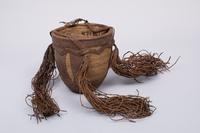
Container in pumpkin shape, leather, raffia, tassels
H 21 cm (without tassels), W 20 cm
Geographical attribution: Sudan
DM VI 26
Object description
Flowerpot-like container made of fine raffia and leather, the richly decorated leatherwork, especially the four hanging leather tassels make it easy to identify the container, conspicuous on the right and on the left are three wide leather stripes running from top to bottom, the upper rim is finished with a zig-zag leatherwork and above it a wider leather braiding, two braided leatherworks, from which the tassels hang, form a hanging device.
Provenance
Kunstmuseen Krefeld (since 1923); Deutsches Museum für Kunst in Handel und Gewerbe (until 1923); previous owner (unknown); transfer to Germany (unknown); appropriation in region of origin (unknown); manufacture (unknown).
Object History
Hagen-born art patron Karl Ernst Osthaus founded the German Museum of Art in Trade and Commerce in 1909 with the support of the Deutscher Werkbund. With the museum, Osthaus pursued the goal of achieving an aesthetic imprint on industrial product design by creating and lending exemplary decorative arts. To this end, the museum lent traveling exhibitions to interested institutions in German-speaking countries and beyond. In 1911, an exhibition on "exotic wickerwork", which was also promoted as "examples of good craftsmanship", was added to the program
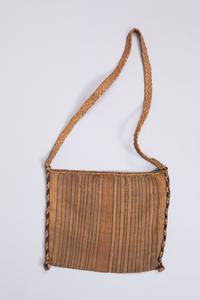
Bast
24 × 20 cm (without strap)
Geographical allocation: Cameroon
DM VI 08
Object description
Bag made of raffia. Bag made of double layered braided mat (colored longitudinal stripes); braided at side edges with two-tone (brown/natural) braided cord closed carrying strap.
Provenance
Kunstmuseen Krefeld (since 1923); Deutsches Museum für Kunst in Handel und Gewerbe (until 1923); previous owner (unknown); transfer to Germany (unknown); appropriation in region of origin (unknown); manufacture (unknown).
Object History
Hagen-born art patron Karl Ernst Osthaus founded the German Museum of Art in Trade and Commerce in 1909 with the support of the Deutscher Werkbund. With the museum, Osthaus pursued the goal of achieving an aesthetic imprint on industrial product design by creating and lending exemplary decorative arts. To this end, the museum lent traveling exhibitions to interested institutions in German-speaking countries and beyond. In 1911, an exhibition on "Exotic Braided Works," which were also promoted as "examples of good craftsmanship," was added to the program. For the "Braided Works Exhibition," objects were obtained through art and ethnographic dealers such as J.F.G. Umlauff, Bruno Antelmann (Deutsches Kolonialhaus), and Rex & Co. So far, however, it remains unclear through whom the companies obtained the objects they offered for sale, and thus also how these objects were extracted from their warehouses, most of which were under European colonial ownership. The bag can probably be located in this context. The bag is described as a "hunting bag" in a list of objects made on the occasion of lending the wickerwork exhibition to Magdeburg. In fact, the intended use of such bags was much broader. They were made for functional purposes as well as for ritual use and are still used today in travel, agriculture and ceremonial contexts.
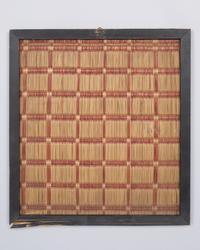
raffia, wood
38,5 × 35,5 cm
Geographical classification: China
DM VI 79
Object description
Piece of a woven mat set in wood; lattice pattern in red and nature.
Provenance
Kunstmuseen Krefeld (since 1923); Deutsches Museum für Kunst in Handel und Gewerbe (until 1923); Rex & Co. (until 1913); transfer to Germany (unknown); manufacture (unknown).
Object history
The woven mat piece was purchased for the DM's wickerwork exhibition in June 1913 through Rex & Co. in Berlin, a store specializing in the import of "Japan, China and Oriental goods." A total of 12 mat samples were ordered for the exhibition, six of which are still extant.
Hagen-born patron of the arts Karl Ernst Osthaus founded the Deutsches Museum für Kunst in Handel und Gewerbe in 1909 with the support of the Deutscher Werkbund. With the museum, Osthaus pursued the goal of creating an aesthetic imprint on industrial product design by investing in and lending out exemplary arts and crafts. To this end, the museum lent traveling exhibitions to interested institutions in German-speaking countries and beyond. In 1911, an exhibition on "exotic wickerwork", which was also promoted as "examples of good craftsmanship", was added to the program.

Beef bast, painted
34 × 26 cm
Geographical allocation: Papua New Guinea
ZV 2000/704
Object description
A cane mask with bark bast overlay; face partly preformed and painted from attached rotan struts; mask colored in white, light brown and dark brown.
Provenance
Verein deutscher Seidenwebereien Krefeld (until unknown); J.F.G. Umlauff (until 1928); transfer to Germany (unknown); appropriation in region of origin (unknown); manufacture (unknown).
Object history
In July 1928, the "Verein der deutschen Seidenwebereien, Krefeld" (Association of German Silk Weavers, Krefeld) purchased a total of ten objects from various regions of the Pacific islands from the Hamburg-based company J.F.G. Umlauff, which specialized in the sale of ethnographic objects. The purchase was made in the wake of the exhibition "Color", which was on display at the Kaiser Wilhelm Museum from May 1 to 31, 1928.
Presumably it is an eharo mask. These were part of the hevehe mask cycle of the Elema society living in the eastern Papuagolf region. Unlike the larger hevehe masks, which were considered sacred and whose production took place in secret, the eharo masks served to entertain and amuse the public at the beginning and end of the mask cycle. The shape and design of the masks, which could represent different beings, figures and characters, varied greatly. Since the 1950s, the hevehe cycle is no longer practiced.
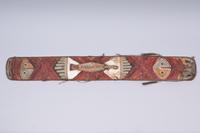
plant fiber, feathers, beads
159 × 21 x 12 cm
Geographical classification: Papua New Guinea
ZV 2000/708
Object description
Shield with depiction of birds; red wickerwork wrapping of plant fiber; with feather and bead hanging; handle is embedded in shield.
Provenance
Verein deutscher Seidenwebereien Krefeld (until unknown); J.F.G. Umlauff (until 1928); previous owner (unknown); transfer to Germany (unknown); appropriation in region of origin (unknown); manufacture (unknown).
Object history
In July 1928, the "Verein der deutschen Seidenwebereien, Krefeld" (Association of German Silk Weavers, Krefeld) purchased a total of ten objects from various regions of the Pacific islands from the Hamburg-based company J.F.G. Umlauff, which specialized in the sale of ethnographic objects. The purchase was made in the wake of the exhibition "Color", which was on display at the Kaiser Wilhelm Museum from May 1 to 31, 1928.
It is probably a battle shield of the inhabitants of the Vitu Islands. The wrapping of spliced red kelp, the carved bird and the painting reminiscent of faces are typical for them. Unlike the dance shields made on the islands, the handle is recessed into the board on the back.
The battle shields could be the embodiment of a protective being, "symbolized by both the bird and human attributes" (Ingrid Heermann).
![Vessel
Metal
16,5 × 11 cm
Japan
CMV 175/618a
Object description
Wickerwork basket made of metal on 3 feet; cylindrical insert closed at the bottom.
Provenance
Crefelder Museumsverein (until 1897); Kunst- und Verlagshandlung R[udolph]. Wagner, Berlin (unknown); transfer to Germany (ca. 1891-1893); appropriation in region of origin (unknown); manufacture (unknown).
Object history
According to the index card, the vessel from Japan, inventoried under the number CMV 175/618a, was purchased from the "Kunst- und Verlagshandlung R[udolph]. Wagner, Berlin" for the collection of the Crefeld Museum Society. Before the First World War, the Berlin-based company was one of the most important sources for museums and collectors of arts and crafts from East Asia. Beginning in the 1880s, the company, founded in 1857 initially as a publishing house, distributed art objects from Japan (Jirka-Schmitz 2018).
According to the old index card of the Kunstmuseen Krefeld, this is supposed to be an incense burner.](https://d1c0wt3y8v1c0a.cloudfront.net/media/attachments/W1siZiIsIjY0ZWY1M2MzNjA0NGJjNjBkZWU0OWNiMiJdLFsicCIsInRodW1iIiwiMjAweD4iLHsiZm9ybWF0IjoianBnIiwib3V0cHV0X29wdGlvbnMiOnsiUSI6NzV9fV1d/CMV_618a_175_975_Foto_Rose_2290.jpg?sha=765958407a3e4655)
Metal
16,5 × 11 cm
Japan
CMV 175/618a
Object description
Wickerwork basket made of metal on 3 feet; cylindrical insert closed at the bottom.
Provenance
Crefelder Museumsverein (until 1897); Kunst- und Verlagshandlung R[udolph]. Wagner, Berlin (unknown); transfer to Germany (ca. 1891-1893); appropriation in region of origin (unknown); manufacture (unknown).
Object history
According to the index card, the vessel from Japan, inventoried under the number CMV 175/618a, was purchased from the "Kunst- und Verlagshandlung R[udolph]. Wagner, Berlin" for the collection of the Crefeld Museum Society. Before the First World War, the Berlin-based company was one of the most important sources for museums and collectors of arts and crafts from East Asia. Beginning in the 1880s, the company, founded in 1857 initially as a publishing house, distributed art objects from Japan (Jirka-Schmitz 2018).
According to the old index card of the Kunstmuseen Krefeld, this is supposed to be an incense burner.
German Museum for Art in Trade and Industry
In 1923, an important collection of applied art was acquired for the Kaiser Wilhelm Museum: the „Deutsche Museum für Kunst in Handel und Gewerbe“ (German Museum for Art in Trade and Industry). The extensive holdings comprise a sample collection of exemplary design, which was intended to educate the general public to good taste and at the same time ensure, in the spirit of a Gesamtkunstwerk, that the proclaimed new aesthetic found its way into everyday life. The important Hagen-based patron and collector Karl Ernst Osthaus had assembled the collection between 1909 and 1919 with the financial and ideational support of the Deutscher Werkbund. Alongside his Folkwang Museum, founded in 1902, the new project reflected even more innovatively and radically the spirit of a new age. After the death of Osthaus, the collection was purchased by the Krefeld Museum Society in 1923 and handed over to the city as a donation in 1928. In the eyes of Max Creutz, director of the Kaiser Wilhelm Museum at the time and a close friend of Osthaus, it perfectly complemented the innovative concept of the museum in Krefeld, which had been developed in the spirit of the reform movement.
The 100th anniversary of the acquisition is the occasion for a complete inventory of the collection of the German Museum for Art in Trade and Industry and a renewed scholarly examination of the collection from a contemporary perspective. With its holdings of several thousand works, the German Museum is perhaps the very first collection of contemporary design. To this day, it forms the core of the Kaiser Wilhelm Museum’s collection in the field of applied art.
The collection, which fell into oblivion in the post-war period, was already partially catalogued and published in the 1980s and 1990s for the exhibition projects The West German Impulse and Beauty and Everyday Life. For the first time, the entire collection is now being inventoried, restored, photographed, and digitized. The previously uncatalogued works are primarily from the large holdings of so-called commercial prints, which—with advertisements, commercial letterheads, visiting cards and menus, typeface sample books, invitations, postcards, etc.—comprise a panorama of cultural history.
In the course of the cataloguing, the fragile stock of paper works will not only be restored and thus preserved for the future, but also archived in digitized form. The digitized copies will make it possible to sustainably preserve the findings for research and will be available for future study. They can also be used for modern knowledge transfer in the digital age.
The cataloguing also makes it possible to gain an overview of all the artistic personalities who Osthaus integrated into his German Museum of Art in Trade and Commerce. In addition to leading figures such as Peter Behrens, Henry van de Velde, Lucian Bernhard, Fritz H. Ehmcke, and Richard Riemerschmid, these also include almost forgotten artists who can be identified on the basis of the inventory as important protagonists of modernism: for example, Johannes Weidenmüller as the forefather of German advertising science, the Berlepsch student Maria La Roche, and Elisabeth Stephani-Hahn as a pioneer of shop window design, to name only a few. They and their colleagues created the foundations of the ideas of consumer culture, advertising, and marketing that are still valid to this day. The exhibition planned for November 2023 and the accompanying catalog will use the research results to shed light on the German Museum with its innovative impulses for contemporary collecting, museum, and mediation activities.
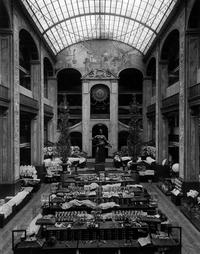
Wertheim department store, Berlin, 1896/1905
First construction phase, atrium
Photography, made by the Institute Dr. Franz Stoedtner
Kunstmuseen Krefeld
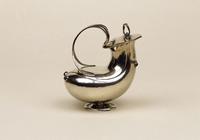
Pot, 1912
Silver, opals
Hagen silver manufacture, Hagen
Kunstmuseen Krefeld
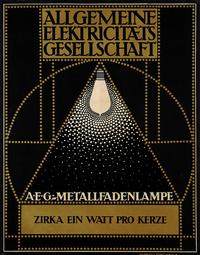
AEG metal filament lamp/Zirka one watt per candle, 1907
Printer: Hollerbaum & Schmidt, Berlin
Color lithograph
Kunstmuseen Krefeld
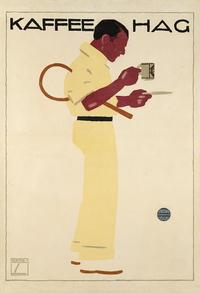
Kaffee HAG, 1913
Printer: Hollerbaum & Schmidt, Berlin
Color lithograph
Kunstmuseen Krefeld
Provenance research Mondrian
Dr. Katja Terlau
Dr. Vanessa-Maria Voigt
The City of Krefeld owns four paintings by the Dutch artist Piet Mondrian (1872–1944): Tableau No. VII, Tableau No. X, Tableau No. XI (all 1925), and Composition IV (1926). They belong to the collection of the Kunstmuseen Krefeld. Descendants of the Mondrian heir Harry Holtzman have demanded the return of the artworks.
In order to clarify whether this claim is legally justified, the City of Krefeld commissioned the two provenance researchers Dr. Katja Terlau and Dr. Vanessa-Maria Voigt to examine the provenance of the paintings.
Between June 2018 and May 2019, the researchers traced the history of the paintings since the 1920s, evaluated archive material, and spoke with experts both in Germany and abroad. In the process, they did not come across any indications that the works could be unlawfully in the possession of the City of Krefeld.
The summary of the researchers' dossier explains the findings in detail.
